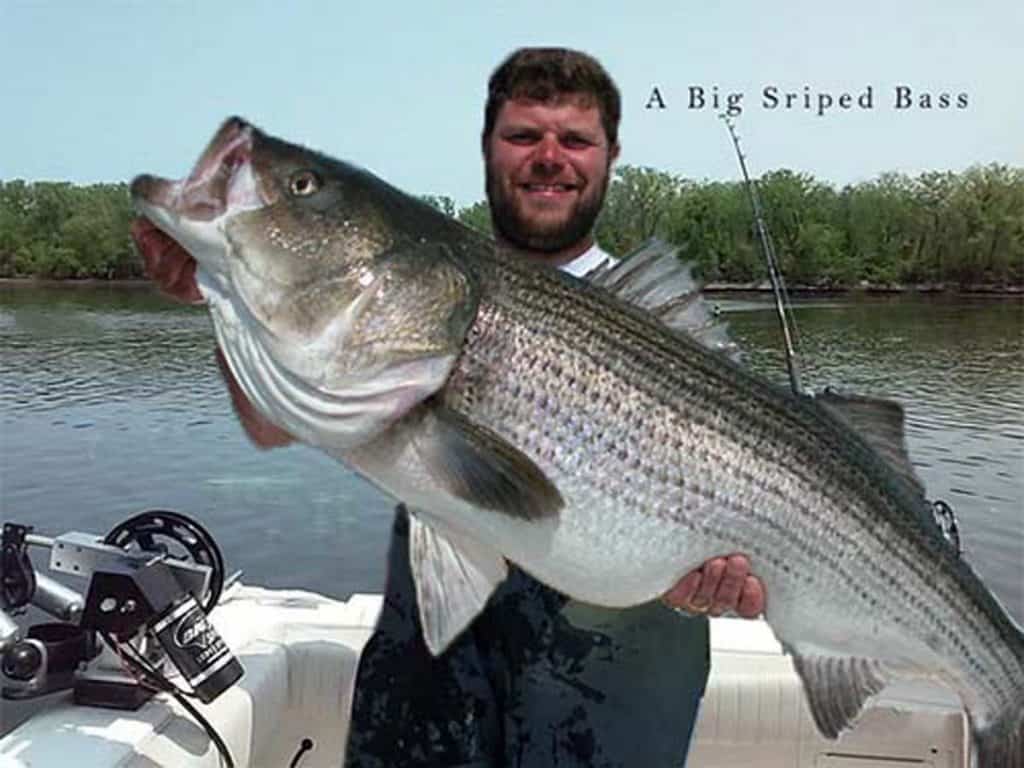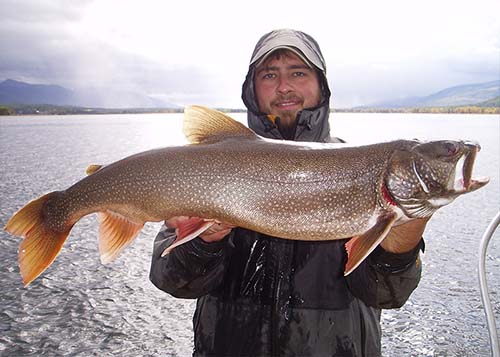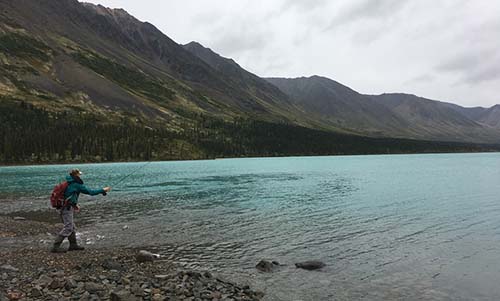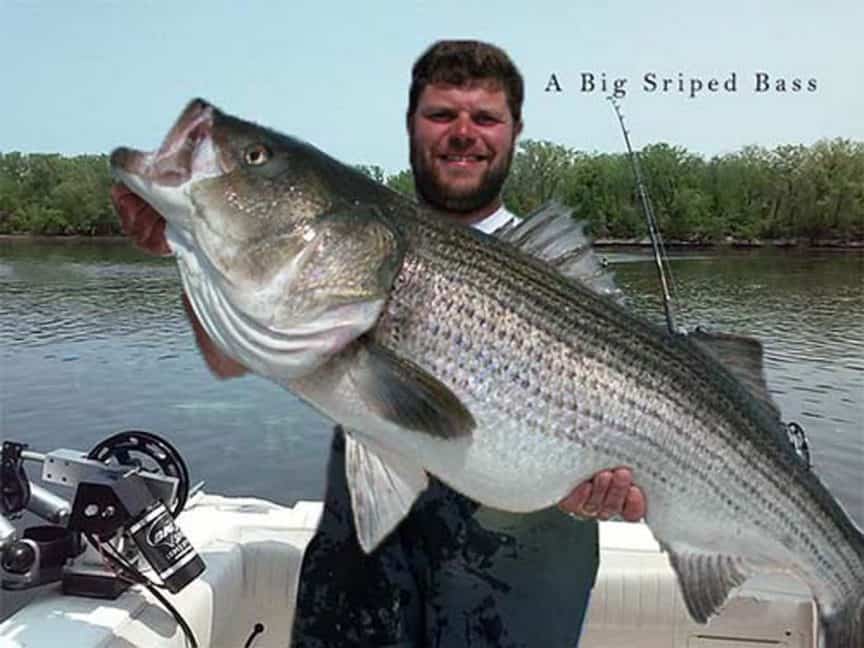It is probably summer. You have been dreaming about hitting the nearest lake or river for some great fishing since fall. Also, you finally want to challenge yourself to go for the bigger fish. However, imagine that you have no clear idea about how to catch big fishes. You have no idea about the type of fish you would like to go for, the time to catch the specific fish, and what tactics to use when fishing big fish.

In this article, we will seek to delve into these aspects. In addition, we will look into the instruments you will need to catch the fish as well as what to expect when fishing in rivers, lakes, or on the shore. Once you catch your big fish, you will be sure to get hooked. (Pun intended)
Types Of Big Fish To Catch
Some people say that the number of fishes you catch is most important. On the other hand, others say that the type of big fish you catch is the real deal.
Whichever side you are on, the first thing to understand is the different types of big fish to catch. They are Paddlefish, Blue Catfish, Largemouth Bass, Lake Trout, Striped Bass, and some others.
Different big fish have different tactics of being caught. Also, they require different instruments because of their difference in size and weight. Lastly, the period or season of fishing is dependent on the type of fish.
So, before going out to strike the bigger fishes, you must decide which fish you are going to try. Below is a detailed view of the different aspects in relation to the type of fish.
Catching A Big Striped Bass!
This is a fish with a streamlined, silvery body marked with longitudinal dark stripes, which run from behind the gills to the base of the tail. It commonly matures to a size of 8-40 pounds with a maximum length of 1.8m.
Period Of Fishing
It is advisable to fish during the end of March to mid-May. This is during springtime.
The reason for this is because the striped bass starts to spawn around this time. This, in turn, will make it difficult to catch as their main focus in on the babies.
Tactic To Use
As much as artificial lures can do the trick, the best tactic to use to catch them is big live bait. The stripers tend to be drawn to this because of the scent and the bigger profile of the baits.
When you drop the bait, the next step is to drop planer boards. Thereafter, use the motor to move throughout the area.
Instruments Required
This type of fish is known to be too big and strong. It is for this reason that you require adequate gear to avoid tackling and busting.
Get A Bigger Lake Trout!

If you want to avoid the hustle and bustle of catching fish, the lake trout is for you. With this fish, you are assured of catching one or more even at the shore.
Period Of Fishing
The best time to go trout fishing is at the beginning of the year all through the end of May. This period offers the best treatment to anglers for a great catch.
Tactic To Use
It is said that one of the best ways to catch this type of fish, is by using three-way rigs. Firstly, gather your school of bait. After that, drop the three-way rig all the way to the bottom.
Here, the wind or current will help push you, which ultimately aids in trolling the bait through the feeding area.
Instruments Required
As opposed to catching striped bass with heavy gear, this fish can easily be caught using light gear regardless of its size. Medium-action 7-foot rods paired with a bait caster can get you started on your fishing adventure.
Fishing Largemouth Bass
They are not necessarily categorized as big fish. However, when you talk about teeners, it fits right into the category of big fishes.
Period Of Fishing
The best time to fish for them is during the month of February. The reasoning behind this is that this is the period they begin to move away from the deeper parts of the water to the shallow ones for spawning.
Tactic To Use
Once you hook your trout as the baits, focus on ledges, humps, and points in the 15-40-foot range. The trick here is to cast from the shallowest point to deep water while letting the bait sink to the bottom. This will ultimately help with steady retrieval.
Instruments Required
You can choose from numerous swimbaits for an assured catch. It all depends on your budget and preference.
Catch Blue Catfish
This type of fish can be caught almost anywhere since they are found in most big rivers and tributaries in the central and eastern parts of the United States.
Nonetheless, James River in Virginia is known to be the best place to get them. As an angler, you can land a fish of up to 50-60 pounds in weight.
Period Of Fishing
For the Blue Catfish, the colder months are known to be the best for an assured catch. This is because big fish become more predictable during this weather.
As long as the bait is there, they will come running. Also, the depth of the water is a non-issue as you catch them as shallow as 6-feet and as deep as 60-feet.
Tactic To Use
The most important thing here is the bait you use to catch the blue catfish. For them to be hooked, use a fresh-cut gizzard shad, preferably in 1-4-inch chunks. These big boys will come rushing like wildfire for it. Going for a blue big catfish is not that much different from catching catfish in general.
Instruments Required
As opposed to the lake trout, with this, you will require hefty gear. This is because this fish is not only huge but also the strongest among the catfish.
Whichever decision you make on the rod and rig to use, the catch here is to fish using multiple rigs where legal. This is a smart way to attract the fish to the bait through the scent.
Go For Paddlefish!
This is a freshwater fish that can be best caught at Grand Lake. They are said to be the biggest and most unusual fish. At this lake, you can land a paddlefish that weighs more than 50 pounds.
Period Of Fishing
Like most other fish, the period to catch them is when they are moving into the tributaries to spawn. For the paddlefish, this is around the months of March and April.
Tactic To Use
They are filter feeders, so a lure or bait will not cut it. You need to snag them. When you find a number of them using your electronics, position your boat above them. After that, position your snag hook to the bottom.
Instruments Required
An 8-foot heavy-action saltwater rod works well when trying to catch them. This is because a long rod moves more line when trying to jerk a hook through the leathery skin of a spoonbill.
How To Catch Big Fishes In Lakes

One of the most popular big fish to catch in a lake is the lake trout. They are mostly found in the cold and deep waters. The following are tips to follow to catch one.
(1) Use A Light-Action Rod
You can use such a rod with a 4 to the 6-pound test line. This is one of the best rods to use as it allows you to use a variety of techniques to catch your trout. The lighter line has less friction with the water, which means you can cast your line to the very bottom of the lake with ease.
Keep in mind that some lake trouts can weigh over 35 pounds. You should, therefore, carry a heavier rod just in case you get one. Also, use either number 6 or number 10 hook to increase your chances of a catch.
(2) Choose A Lure Mimicking Native Baitfish
Lake trouts are known to feed on a number of different native species. Therefore, the best lure is one that closely mimics their individual food preferences.
Ask around local bait and tackle shops if you are not sure about which lure is best. The small weightless lures and spinners make the best artificial baits. Additionally, you can add shiny metal foil or beads to further attract the trout.
(3) Live Bait
If you plan on using live bait, nightcrawlers, minnows or salmon should be your best picks. Minnow traps and nets will be useful for the task. Ask the local bait shop about what the fish in your area have been biting lately.
It is important to note that fish have different preferences depending on the season and region. To keep the live bait alive we should use proper livewell pumps for aerating the tank.
(4) Use A Fishfinder GPS Combo
If you can manage an appropriate fishfinder GPS combo to locate the fish and to get some additional information about the lakes and rivers that should be great. This can help but not an essential thing to have. One can fish well without these machines too.
How to Catch Big Fishes in A River
With rivers, a point to remember is that some are fast flowing, others are slow moving and almost all of them are shaped differently. On top of that, they all have a variety of different shelters by the shoreline. These, on top of the equipment needed and type of fish to catch, are all important points when catching big fishes in rivers.
(1) Be Keen On The Sheltered Spaces
The biggest tip here is to look for areas that are calm in the river as they are most popular for the growth of weeds. With weeds comes a large number of big fishes such as the largemouth bass.
In addition, the lighter the currents the better. Also, with areas where they are overhanging trees, you are most likely to find fish in the shelter.
(2) Contact The Locals
The best advice and guidance come from the people living in the area you would like to fish. Ask questions from the local bait shop in regards to the bait they use and how the weather is dependent on the location of the fish.
Additionally, ask about the best time to catch fish. Talk to other anglers who are found up and down the area as well.
(3) Use Live Bait Bouncing To Trick The Fish
This is one of the most effective tips. Hook yourself up with some live bait and bounce it off the bottom of the river bed, in the direction of the current to make it look natural. The fish will fall for this trick and you will have your successful catch.
(4) Use The Right Colors To Fish
The colors of the bait play a major role in catching fish. Many baits can be used for different types of fish. It is advisable to use red and yellow baits as they attract the fish down to the river bed. This, in turn, increases the rate of success in getting your catch.
(5) Use X-Ray Vision
This is not meant to be taken literally. What this means is that you can use a pair of polarized glasses that will help you see through the water. This will guide in seeing the fish you would like to catch.
This tip is however dependent on the river you are fishing and weather conditions. All in all, remember that fishing can be dangerous because of different types of currents and depths. Also, be considerate of other anglers fishing in the same river to avoid accidents and misplacement of gears.
How to Catch Big Fishes From Shore
If you do not have a boat or want to avoid the expense and hassle of boat ownership, fishing on the shore is the best for you. When catching big fish from the shore, you will require lots of commitment, practice, and attention to detail.
(1) Walk Around
The first thing to do when you get to a shore fishing location is not to start casting. You should take a walk around the perimeter of the shore and observe the water body.
Look for any fishy structure such as vegetation. After you have come up with a good mental layout of the spot, create a game plan before you begin fishing. This will ensure you concentrate on the most productive areas. At this point, be on the lookout for a big fish like the striped bass. Also, see if there is a bunch of baitfish, as this will draw you to the big fish.
(2) Stay Low
Most shore fishing spots such as ponds and streams do not provide you with a way of staying under cover. Here, you can easily blow your cover and the fish may disappear even before you cast.
If you can, try and stand next to a tree, some grass, or dock piling to hide your shadow. If it is sunny, keep your shadow away from the water because most fish identify shadows with birds of prey and herons. This means that they will move away when your shadow is visible.
(3) Cast Parallel
Most people assume that with shore fishing, you should lob a cast far towards the middle of the water mass. However, this is a mistake because most of the big fishes hang around the shore or on the first major drop-off close to the shore.
Therefore, avoid casting too far and make parallel cuts along the bank or quartering away. This, in turn, keeps your bait in the capture zone longer, thus resulting in more bites.
(4) Downsize The Baits
You will catch more fish if you use baits and presentations that closely take after the big fish you are trying to catch. On the shore, where the water is shallow, the most used baitfish species are generally stunted panfish and minnows.
As a piece of advice, downsize your baits to increase the action. For example, if you are fishing a worm, opt for a 4- or 5-inch model rather than a 9-inch.
(5) Pack Light
When fishing at the shore, your movement tends to be limited. You can only fish until where your feet can go. This means lots of walking for you. Imagine that, coupled with carrying a bunch of rod or reel combos and tackle box. It is too much work.
The smartest thing to do is to pack light. Choose a single multi-purpose rod/reel combo and a small backpack with a few baits. Ultimately, walking will be easier and you will have more time focusing on making a catch other than installing the gear.
Catching Bigger Fishes At Night
For catching larger fishes at night is sometimes better than the day time. There are always fewer competitors for the fish at night. The technique is to use underwater fishing lights for night fishing. These lights attract a big amount of small fishes, minnows, and insects to the light which is your fishing spot actually.
Then, the bigger fishes come to minnows and the to other insects like a storm. That is when you should capture them with patience.
Conclusion
If you know how to catch big fishes then you must agree that patience, dedication, experience, and luck everything is important for catching bigger fishes like a striped bass or lake trout or something else.
Only strategy, techniques, and instruments will not be enough sometimes. Motivation and confidence will definitely help in difficult moments. Be calm, your turn will come automatically.



